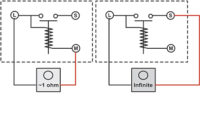Troubleshooting these devices includes testing their inputs, programming, hardware, and generated outputs. In this column we will discuss some basic troubleshooting techniques that can be used to test their inputs.
Microprocessor controllers can be designed to use a variety of different inputs; however, they can be divided into two basic groups: digital and analog inputs. A digital input is a simple open or closed contact point. An analog input is a varying resistance, voltage, or amperage signal.
Since a digital input is basically some type of simple contact closure, you can troubleshoot this type of input just like any other mechanical switch. Using an ohmmeter, disconnect the input electrically and test if the switch is open or closed. If it is open and should be closed, you have an issue with the input. Another approach is to test voltage level at a controller.
Normally the controller will be looking for one of two voltage levels: either a low voltage signal or a high voltage signal.
For example, if the controller is designed to “see” either 0 volts or 24 volts and you measure 0 volts when it should be 24 volts, there is a problem with the input.
Testing analog inputs is a little more complex. The type of analog input will determine the method to use. A varying resistance input can be tested by electrically disconnecting the sensor and measuring both the sensor’s resistance and its applied variable (typically temperature) and then comparing it to the manufacturer’s published values.
For example, if the input is an NTC thermistor (which is a temperature sensor whose resistance changes based on a change in temperature), you can test it by measuring both the temperature sensed by the thermistor and its resistance and then comparing the measured resistance to a chart published by the manufacturer.
If a manufacturer states that at 70°F its thermistor should have a resistance of 10,000 ohms, and you measure a resistance different than 10,000 ohms, the thermistor is faulty and needs to be replaced.
The process is similar to test voltage/amperage based inputs. Measure the applied variable (temperature, pressure, etc.) and the voltage/amperage signal from the sensor to the controller. You can use simple mathematics to determine the correct input (voltage/amperage) level to the control and compare it to the measured voltage/amperage level at the controller. These sensors will typically have two published ranges:
1. The measurable valuable range (for example, a pressure sensor could be rated for a 0 to 100 psig range).
2. An output signal range which could be designed at 0 to 10 vdc (volts direct current) or 4 to 20 mA. You can use these ranges to determine the correct output for the sensor.
For example, if a pressure sensor with a 0 to 100 psig pressure range and a 0 to 10 vdc output range has an applied pressure of 50 psig, an expected output signal would be 5 vdc. Comparing the calculated voltage to the actual measured voltage will allow you to determine if the sensor is operating correctly.
Verifying and/or testing the inputs of a microprocessor controller are important tasks when troubleshooting their operation. Failing to identify a faulty input can lead to an incorrect replacement of these expensive controllers.
Publication date: 11/12/2012









